When you’re scaling a content operation, the tools you use can make or break your momentum.
Two platforms stand out for marketers serious about SEO: MarketMuse and Surfer.
Both promise better rankings, smarter workflows, and AI-assisted content creation. Both serve marketers, writers, and SEOs looking to compete in a crowded search landscape.
But once you go beyond the surface, the differences are clear.
MarketMuse is built for enterprises and large content teams that require deep strategy and multi-layered planning.
Surfer is built for growth-focused teams–offering speed, performance, and now full-scale content strategy with powerful execution tools.
It’s also designed to maximize your brand’s visibility in both classic search engines and emerging AI search platforms like ChatGPT, Perplexity, and Google’s AI Overviews.
If you're a CMO or marketing leader looking to increase traffic without bloating headcount or blowing up budgets, this breakdown is for you.
What You’ll Find in This Article
- Where MarketMuse shines for enterprise strategy
- Where Surfer delivers faster, more measurable SEO results
- How both tools handle AI, optimization workflows, and collaboration
- Which platform gives you everything you need to grow traffic with confidence
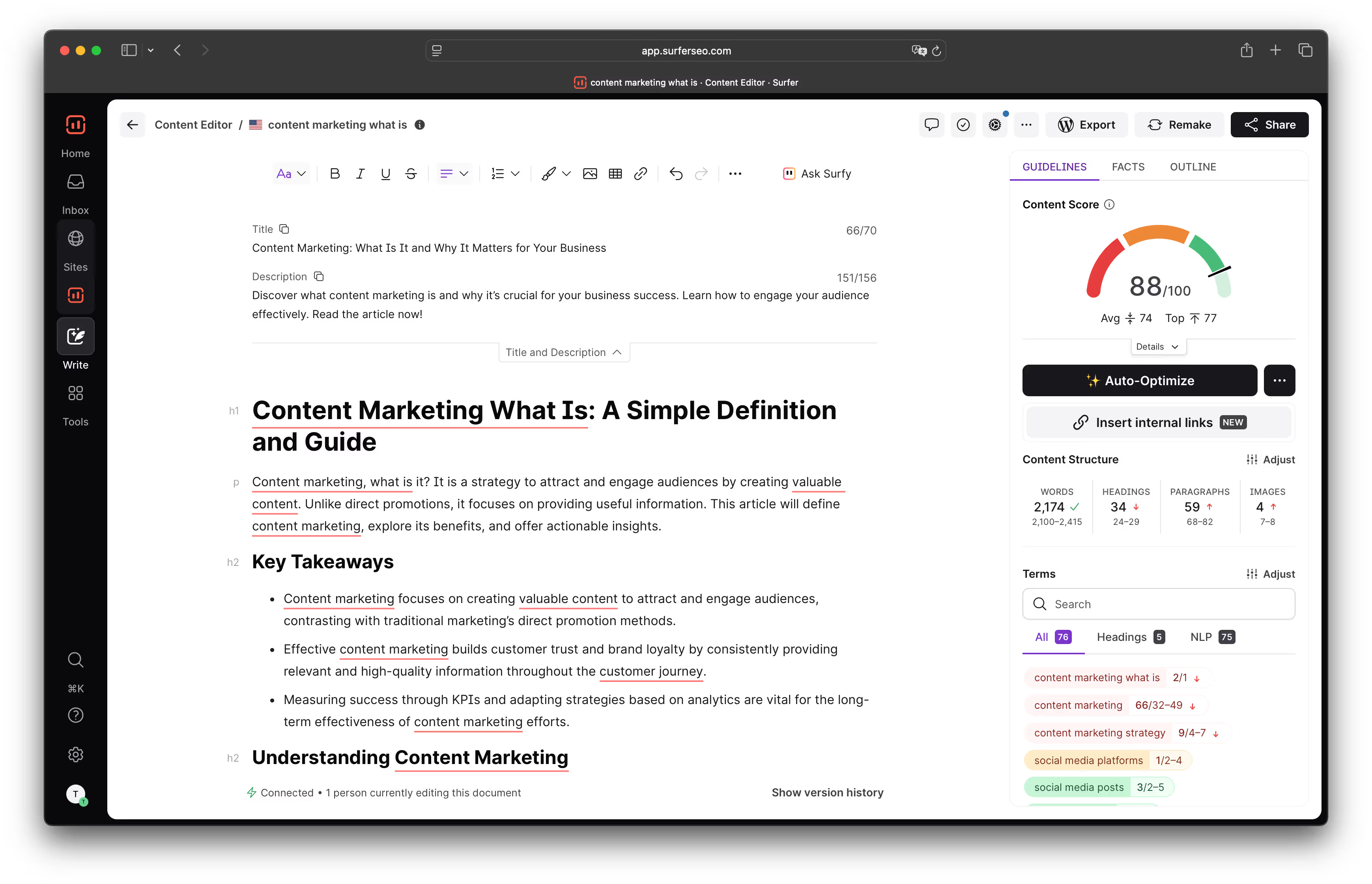
MarketMuse vs SurferSEO: TL;DR
MarketMuse gives you deep audits, topic modeling, and AI-powered content briefs designed for content strategists. But it comes with a high price tag, a steeper learning curve, and more complexity than most teams need.
Surfer is built for growth-focused teams–offering speed, performance, and full-scale content strategy with powerful execution tools.
It’s also one of the few platforms designed to help you grow visibility in both traditional search and AI-powered discovery engines like ChatGPT, Perplexity, and Google’s AI Overviews.
With Surfer you also get:
- A real-time site inventory and audit system (Sites + Content Audit) gives you a live view of what's working and what needs updating
- AI-powered content briefs help writers produce SEO-ready drafts faster, with guidance that actually reflects what ranks
- Topical Maps show you what to write next and how to structure your content to win whole topic clusters
- Internal link suggestions, content decay monitoring, and AI search visibility tools keep your strategy working long after publishing
In short: Surfer helps your team create, optimize, connect, and maintain high-performing content–at scale.
If you’re scaling content production and want fast, reliable SEO results–Surfer is the better fit.
Content Strategy & Planning: Both Do It. One Does It Faster.
MarketMuse built its reputation on content strategy. It analyzes your site, surfaces content gaps, and recommends what to write next based on topical relevance and opportunity.
But here’s the thing: Surfer does that too–faster, and in a more usable way.
Surfer’s Sites feature gives you a live inventory of all your content, showing performance by URL and keywords. It flags underperforming pages, outdated content, and new content opportunities–all in one place.
Pair that with Content Editor, and you can instantly diagnose what’s holding a page back, what keywords to add, what topics to cover, and what internal links to include.
Want to know what to publish next? Surfer’s Topical Maps build entire topic clusters for you, automatically. You’ll see what content to create, what order to publish it in, and how it supports your authority on that subject.
Why it matters:
MarketMuse gives you a roadmap. Surfer gives you a real-time dashboard–and the car to drive it.
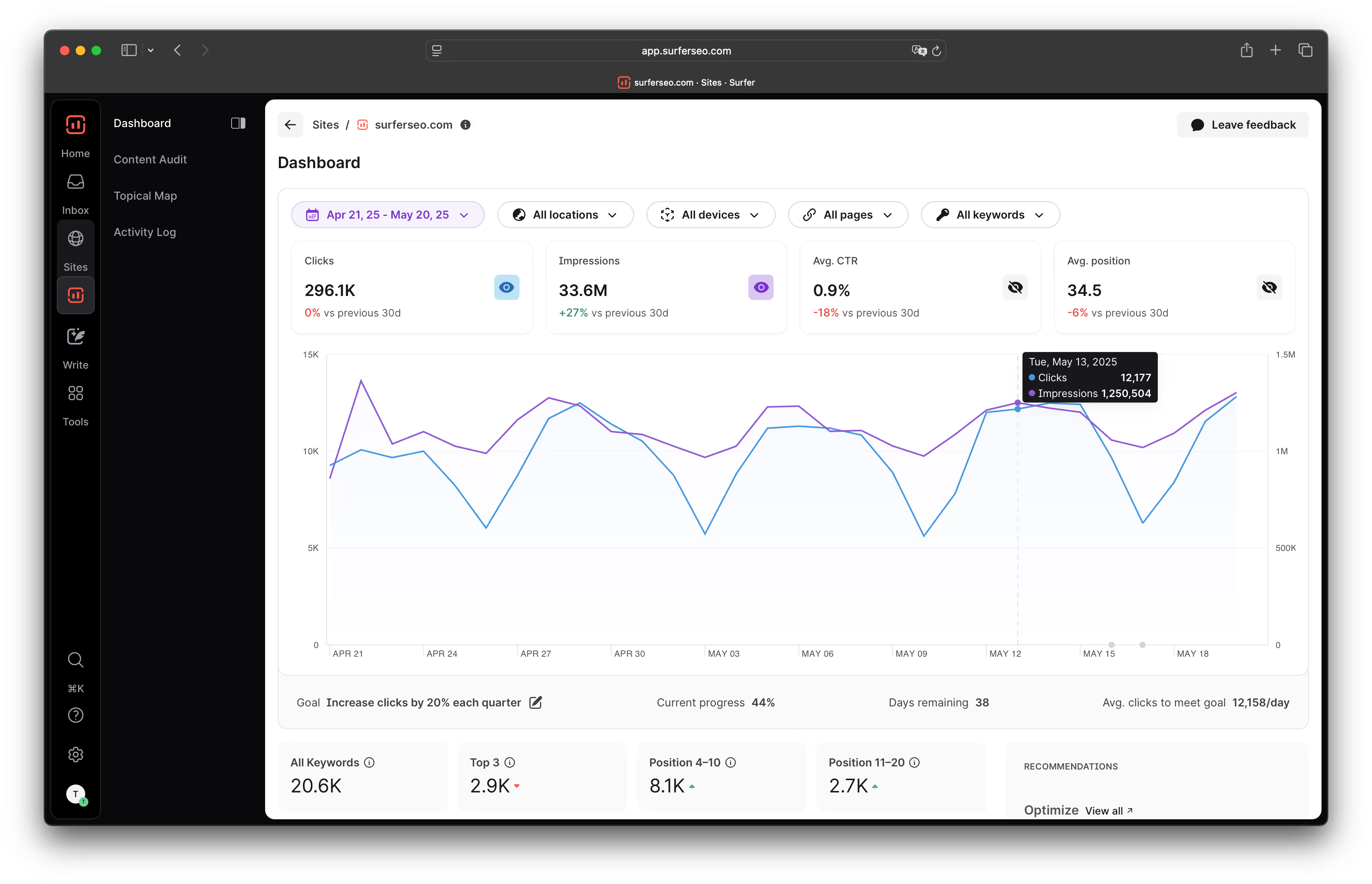
Content Scores: Which One Actually Reflects Rankings?
Both platforms use a Content Score to tell you how optimized a piece is.
But there’s a big difference in reliability.
MarketMuse gives you a proprietary score based on term usage and topic coverage. It’s useful, but MarketMuse hasn’t shared whether that score correlates with actual Google rankings.
Surfer’s Content Score, on the other hand, is backed by data. Third-party studies and Surfer’s own research show a 0.28 correlation between high Content Scores and high Google rankings.
Why it matters:
If your team uses a score to judge content quality, it needs to be anchored in reality. Otherwise, they could spend hours “optimizing” content that never had a chance of ranking.
Surfer’s score gives your team a clear, performance-backed target–so they know when content is ready for primetime.
Optimization Workflow: Strategic Depth vs Execution Power
MarketMuse is excellent at helping you decide what to write. But once you’re inside the writing process, you’re mostly on your own. There’s little support for drafting, refining, or improving content in real time.
Surfer is built for action. Its optimization workflow supports the entire lifecycle of content, from idea to publication:
- NLP-driven suggestions while you write
- Content gap analysis to see what your competitors included
- Auto Optimize to enhance structure and keyword usage
- Coverage Booster to ensure you’re going deep enough
- LLM optimization tools to align with AI-generated search experiences
Why it matters:
SEO isn’t just about planning–it’s about consistent execution. Surfer turns every article into an opportunity to rank, with guidance built into the writing workflow.
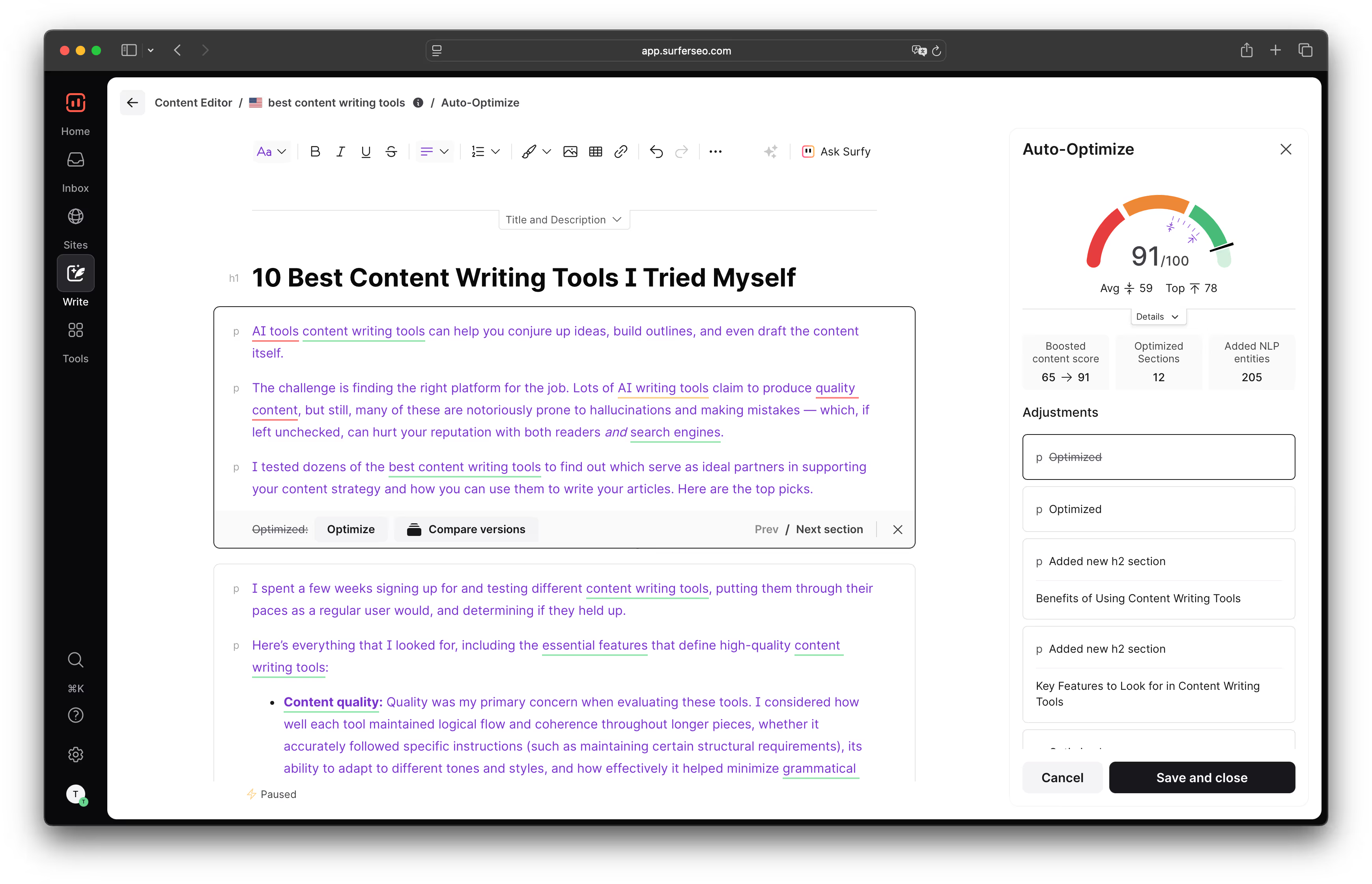
AI Writing: From Drafting to Performance
MarketMuse gives you full-length AI-generated drafts based on rich briefs. That’s great for solo creators or when you’re stuck at square one. But many teams find the output requires heavy rewriting to match brand tone, SEO structure, or factual accuracy.
Surfer takes a different route. It doesn’t try to write entire articles from scratch—instead, it helps you refine what you’ve already written.
Surfer’s AI assistant, Surfy, learns your tone, edits weak sections, enhances keyword placement, suggests headers, and improves overall structure. It’s supported by Auto Optimize and Coverage Booster, which takes a draft and turns it into a publication-ready asset with just a few clicks.
Why it matters:
Creating content is easy.
Creating content that performs? That’s where most teams struggle.
Surfer makes your team’s content better, not just faster–so the final output actually earns traffic.
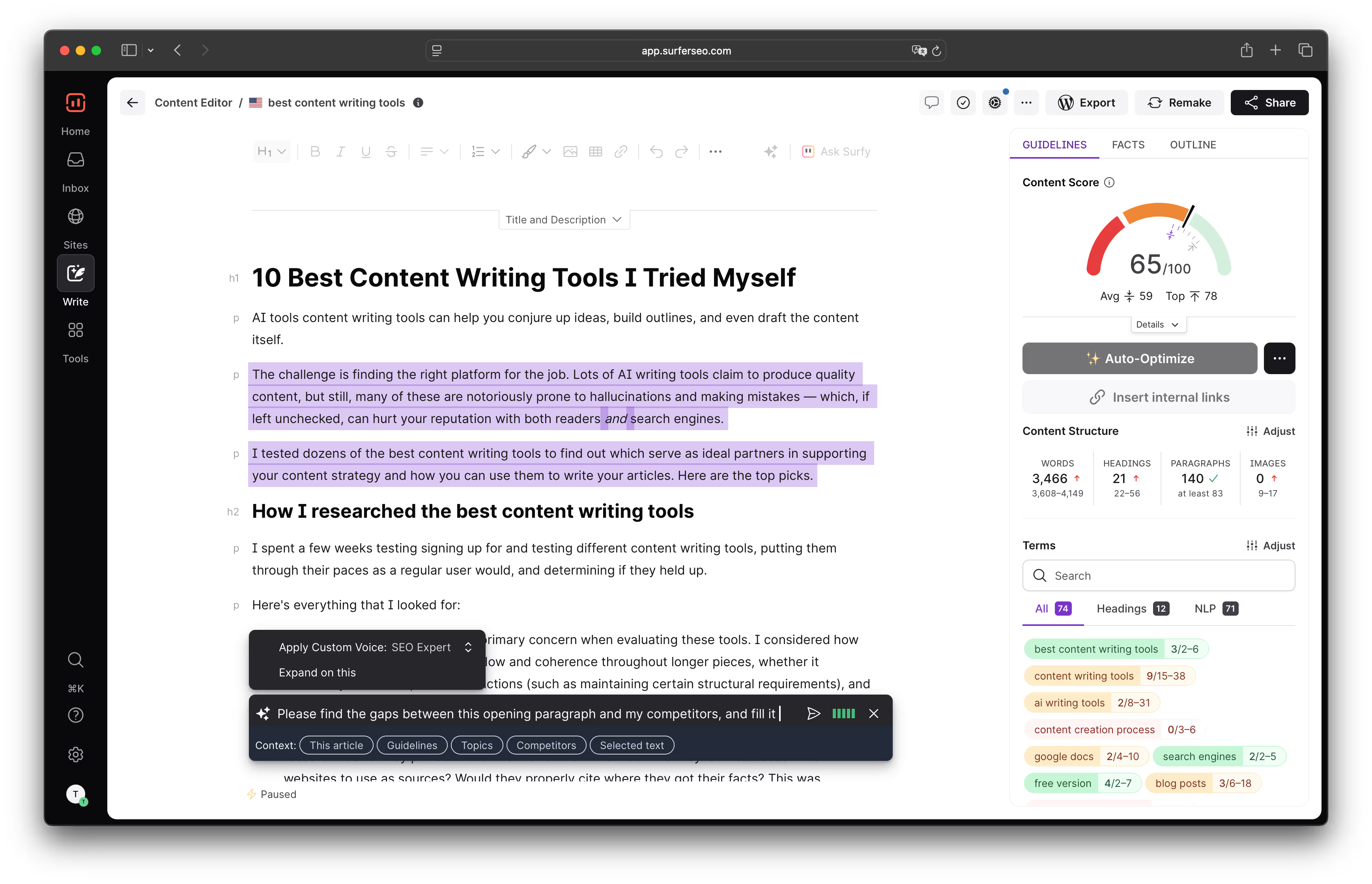
Internal Linking: Automated vs Manual
MarketMuse does a great job telling you what content to create or update–but it offers little support for one of SEO’s most important factors: internal linking.
Surfer automates it.
By connecting to Google Search Console, Surfer scans your existing content, identifies internal link opportunities, and lets you insert them with one click inside the editor.
Why it matters:
Internal links help Google understand your site structure, boost underperforming pages, and increase topical authority. But because they’re boring and manual, they’re often skipped.
Surfer makes them part of the workflow–so they get done, every time.
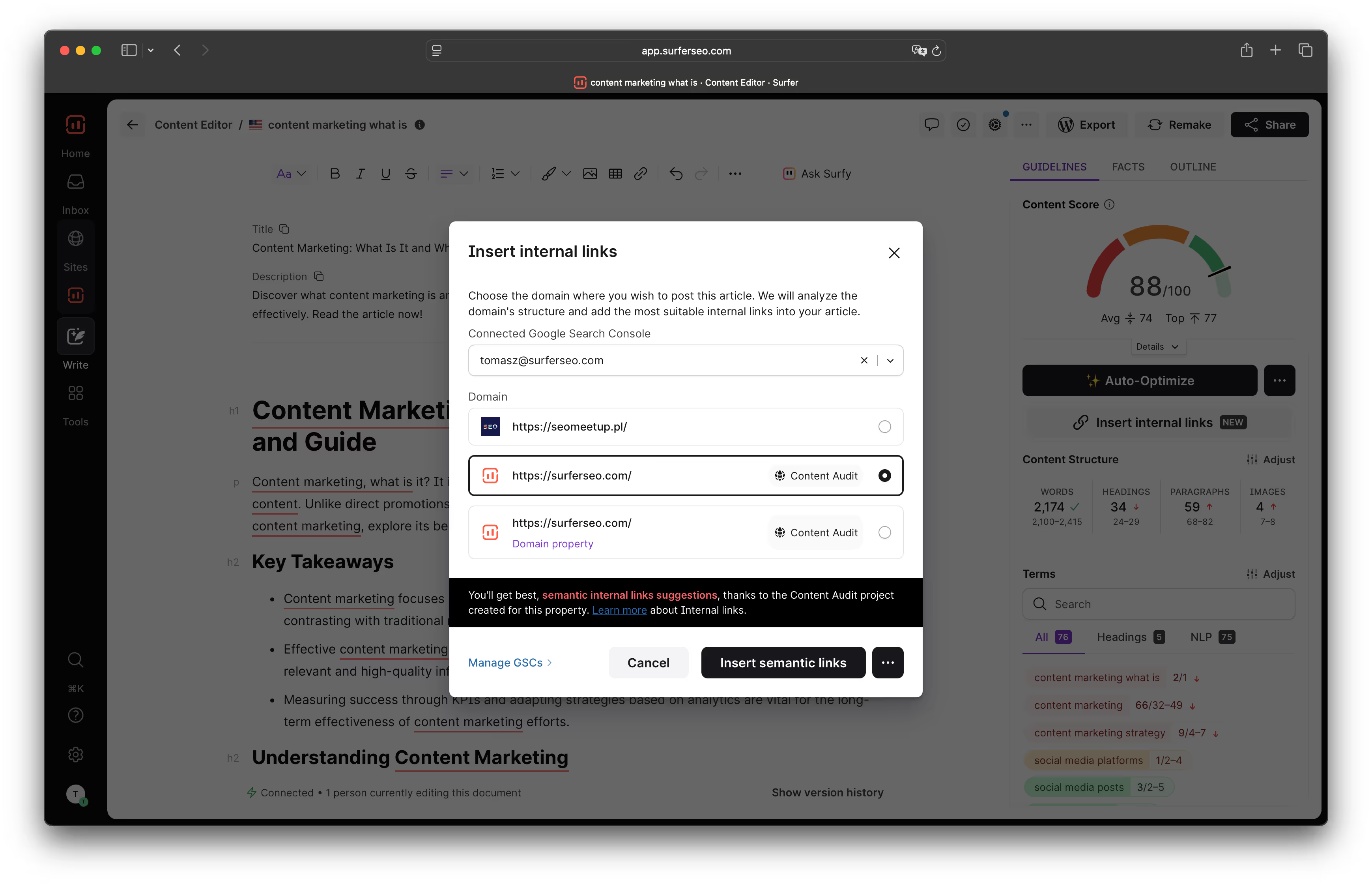
Content Monitoring & Updates: Visibility vs Action
Both tools offer visibility into content performance post-publication.
But only one of them actually helps you do something about it.
MarketMuse gives you content analytics and site-level insights. But if a page drops in rankings, it’s on you to investigate, decide what to fix, and do it manually.
Surfer handles it for you.
With its Content Audit and Content Editor tools, Surfer tracks rankings, spots declining content, and suggests weekly updates–often with one-click fixes.
Why it matters:
Publishing content isn’t enough. If you don’t maintain it, you’re leaving rankings (and traffic) on the table.
Surfer helps protect your investment by keeping your content fresh and competitive–automatically.
That includes adjusting for how your content appears in AI search platforms and surfacing opportunities to regain lost AI visibility via Surfer’s AI Tracker.
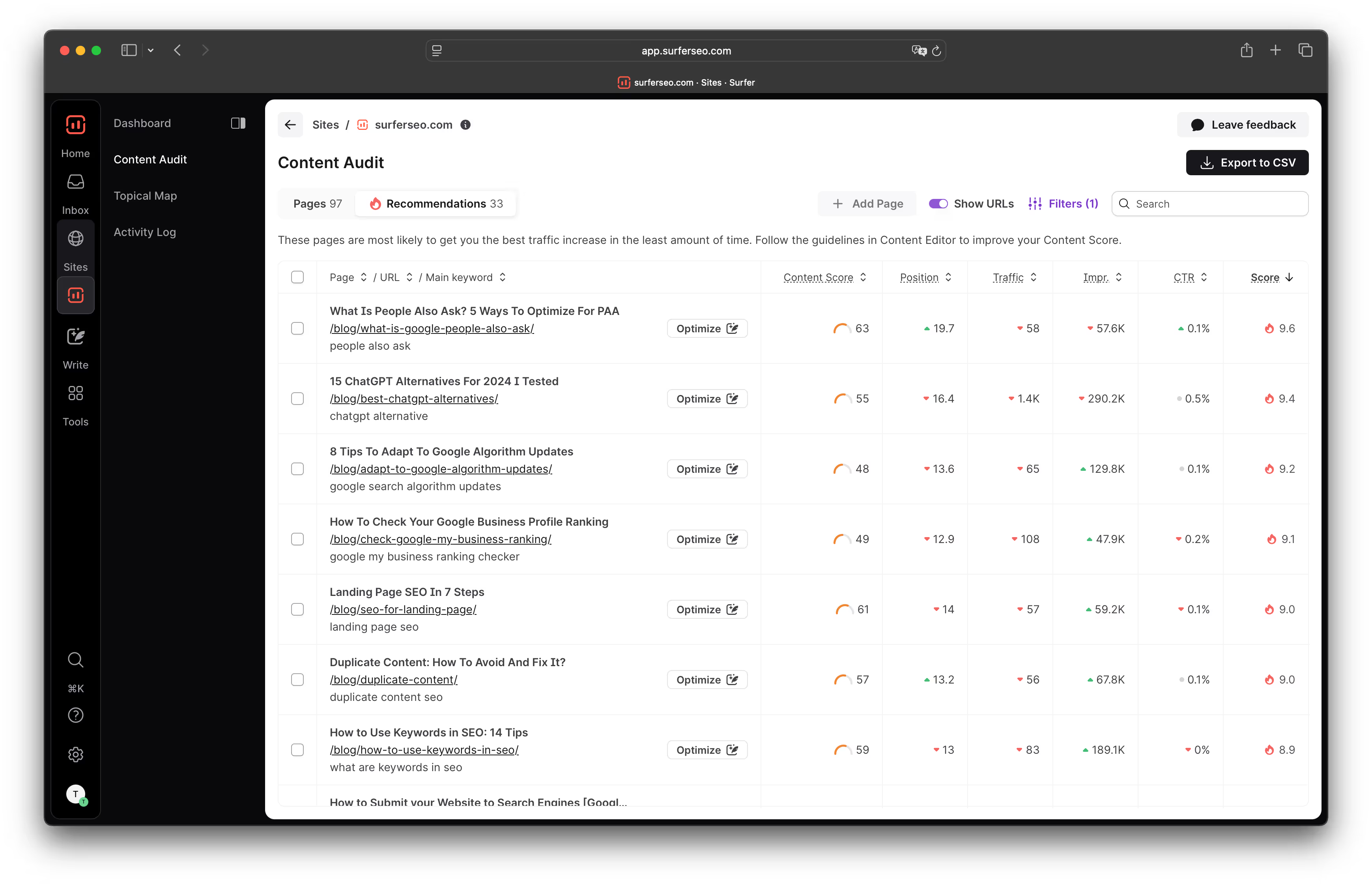
Team Collaboration: One-Person Tool vs Built for Teams
MarketMuse was designed for strategists–not necessarily for collaboration. The interface is powerful, but not intuitive. You’ll likely end up bouncing between MarketMuse, Docs, Slack, and spreadsheets.
Surfer was built for content teams.
Inside the Content Editor, your writers, editors, and SEOs can collaborate in real time–leaving comments, tracking changes, and sharing drafts with stakeholders.
It also integrates directly with Google Docs, WordPress, and Jasper, so your team doesn’t have to change how they work.
Why it matters:
Content is rarely a solo job.
Surfer supports the way modern teams work together, making collaboration seamless from draft to publish.
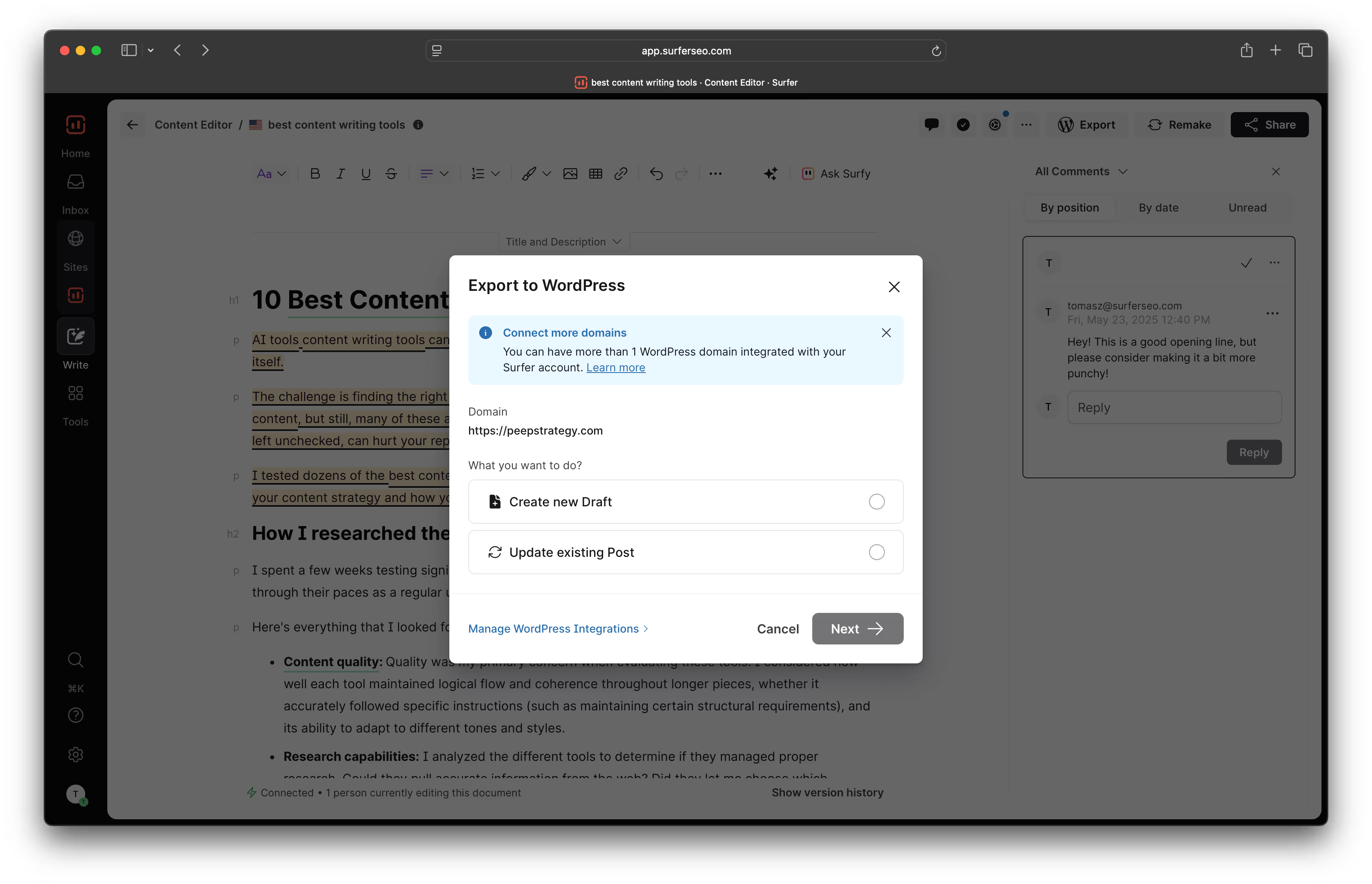
Topic Modeling & Topical Authority: Surfer Takes It Further
MarketMuse is often credited for introducing the concept of personalized difficulty–estimating how hard it will be for your specific domain to rank for a topic based on your existing authority and internal links.
But Surfer offers personalized difficulty too. When researching keywords, Surfer doesn’t just show a generic difficulty score–it factors in your domain’s real-world performance data (from Google Search Console) to estimate which keywords are worth targeting, right now.
Instead of static suggestions, Surfer builds a visual map of an entire niche–breaking it into content clusters with clear interlinking paths.
It tells you what to write, when to write it, and how it fits into your topical authority.
Unlike MarketMuse, which often requires manual interpretation, Surfer gives you ready-to-execute content plans designed to grow your organic visibility in Google and AI-powered search results.
This makes it easier to build the kind of deep topical coverage that AI models recognize and prioritize when generating answers.
Why it matters:
Modern SEO and visibility in AI search is about depth, structure, and coverage.
Surfer makes topical authority actionable.
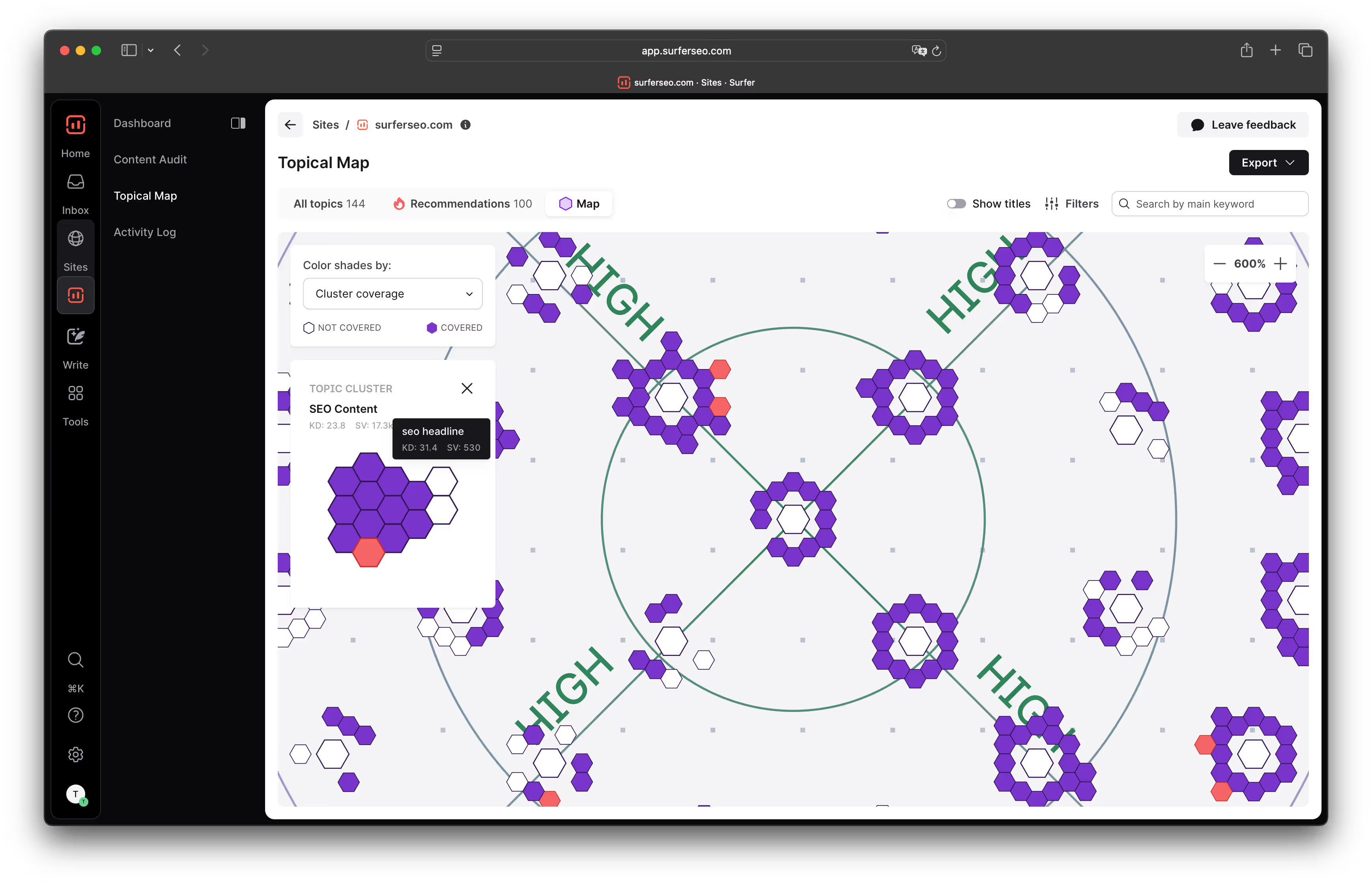
AI Writing: Fully Automated, SERP-Aware, and Customizable
While MarketMuse includes an "AI Assistant" for drafting and outlining, it lacks full automation and deep integration with live search results. Its outputs are often disconnected from SERP realities, requiring manual interpretation and rewriting.
Surfer takes a different approach. With Surfer AI (our AI Writer), you can generate ready-to-rank articles fully automatically–using templates grounded in live SERP data.
Choose from:
- Predefined templates optimized for different content types
- Dynamic templates based on what's currently ranking (SERP-based)
- Custom templates that reflect your brand structure, tone, and goals
You can even set a custom voice to match your writing style–ensuring that AI-written content sounds like you, not a bot.
Why it matters:
Surfer isn’t just about speeding up content creation–it’s about getting to publish-ready, performant content with minimal manual editing.
That’s a game changer for small teams with big growth goals.
Content Repurposing: Turn Blog Posts into Social Media in Minutes
This is where Surfer quietly wins big.
Surfer helps you repurpose your existing content into social media posts, email copy, and more–instantly.
With Surfy's contextual understanding of your long-form content, you can for example generate LinkedIn post ideas from published blogs.
MarketMuse doesn’t support content repurposing workflows.
Why it matters:
Content teams today need more than just traffic–they need reach. Surfer extends the impact of every piece you publish by helping you spread it across multiple channels, without starting from scratch.
Surfer: More Than a Content Tool
While this comparison focuses on content workflows, it’s worth noting that Surfer is a full-stack SEO platform, not just a writing assistant.
It includes:
- Content Audit (aka site inventory): See what’s working, what’s not, and what to update
- AI Content Briefs: NLP-backed suggestions with full structure, terms, and real-time SERP context
- Topical Maps: Visual topic modeling built for execution
- Keyword Research: Find opportunities your competitors missed
- Integrations: Work inside your favorite tools
- AI Tracker: Track your brands visibility in ChatGPT, AI Overviews, AI Mode, Perplexity and others
Whether you’re a solo operator or a 20-person content team, Surfer gives you everything you need to grow traffic with confidence.
Comparison Table
Final Thoughts: Which One’s Better for You?
MarketMuse is a strong fit for enterprise content teams with dedicated strategists, large budgets, and complex content operations. If your team needs deep inventory planning and long-term roadmapping–and you can absorb the cost–it’s a solid platform.
But for most CMOs and marketing leaders at small to mid-sized businesses, Surfer is the better choice.
It gives your team:
- A real-time content inventory system with page-level and site-wide insights
- AI-powered briefs that support collaboration and performance
- Topical Maps that help you win entire topics–not just keywords
- A complete SEO workflow: planning, execution, optimization, maintenance
Less guesswork. More rankings. Better results.
That’s what scaling with Surfer looks like.


.avif)